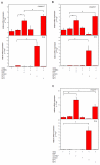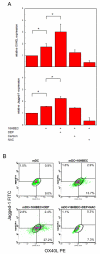Diesel exhaust particle-treated human bronchial epithelial cells upregulate Jagged-1 and OX40 ligand in myeloid dendritic cells via thymic stromal lymphopoietin
- PMID: 20974985
- PMCID: PMC3927452
- DOI: 10.4049/jimmunol.1000719
Diesel exhaust particle-treated human bronchial epithelial cells upregulate Jagged-1 and OX40 ligand in myeloid dendritic cells via thymic stromal lymphopoietin
Abstract
Ambient particulate matter, including diesel exhaust particles (DEP), promotes the development of allergic disorders. DEP increase oxidative stress and influence human bronchial epithelial cell (HBEC)-dendritic cell interactions via cytokines, including thymic stromal lymphopoietin (TSLP). Upregulation of TSLP results in Th2 responses. Using primary culture HBEC and human myeloid dendritic cell (mDC) cocultures, we show in this study that DEP upregulation of Th2 responses occurred via HBEC-dependent mechanisms that resulted from oxidative stress. Moreover, DEP-treated HBEC and ambient particulate matter-treated HBEC upregulated OX40 ligand (OX40L) and the Notch ligand Jagged-1 mRNA and expression on mDC. Upregulation of OX40L as well as Jagged-1 on mDC required HBEC and did not occur in the presence of N-acetylcysteine. Furthermore, OX40L and Jagged-1 upregulation was inhibited when HBEC expression of TSLP was silenced. Thus, DEP treatment of HBEC targeted two distinct pathways in mDC that were downstream of TSLP expression. Upregulation of OX40L and Jagged-1 by mDC resulted in mDC-driven Th2 responses. These studies expand our understanding of the mechanism by which ambient pollutants alter mucosal immunity and promote disorders such as asthma.
Figures








Similar articles
-
MicroRNA-375 regulation of thymic stromal lymphopoietin by diesel exhaust particles and ambient particulate matter in human bronchial epithelial cells.J Immunol. 2013 Apr 1;190(7):3757-63. doi: 10.4049/jimmunol.1201165. Epub 2013 Mar 1. J Immunol. 2013. PMID: 23455502 Free PMC article.
-
Diesel exhaust particle-exposed human bronchial epithelial cells induce dendritic cell maturation and polarization via thymic stromal lymphopoietin.J Clin Immunol. 2008 Mar;28(2):147-56. doi: 10.1007/s10875-007-9149-0. Epub 2007 Nov 30. J Clin Immunol. 2008. PMID: 18049884 Free PMC article.
-
Myeloid dendritic cells are primed in allergic asthma for thymic stromal lymphopoietin-mediated induction of Th2 and Th9 responses.Allergy. 2014 Aug;69(8):1068-76. doi: 10.1111/all.12435. Epub 2014 Jun 3. Allergy. 2014. PMID: 24888572
-
Thymic stromal lymphopoietin, OX40-ligand, and interleukin-25 in allergic responses.Clin Exp Allergy. 2009 Jun;39(6):798-806. doi: 10.1111/j.1365-2222.2009.03241.x. Epub 2009 Apr 7. Clin Exp Allergy. 2009. PMID: 19400908 Free PMC article. Review.
-
Cellular and molecular mechanisms of TSLP function in human allergic disorders--TSLP programs the "Th2 code" in dendritic cells.Allergol Int. 2012 Mar;61(1):35-43. doi: 10.2332/allergolint.11-RAI-0376. Epub 2011 Dec 25. Allergol Int. 2012. PMID: 22189594 Free PMC article. Review.
Cited by
-
Clara cell 10-kDa protein inhibits T(H)17 responses through modulating dendritic cells in the setting of allergic rhinitis.J Allergy Clin Immunol. 2013 Feb;131(2):387-94.e1-12. doi: 10.1016/j.jaci.2012.11.027. Epub 2012 Dec 28. J Allergy Clin Immunol. 2013. PMID: 23273949 Free PMC article.
-
The Role of Airway Epithelial Cell Alarmins in Asthma.Cells. 2022 Mar 24;11(7):1105. doi: 10.3390/cells11071105. Cells. 2022. PMID: 35406669 Free PMC article. Review.
-
Air Pollution and Climate Change Effects on Allergies in the Anthropocene: Abundance, Interaction, and Modification of Allergens and Adjuvants.Environ Sci Technol. 2017 Apr 18;51(8):4119-4141. doi: 10.1021/acs.est.6b04908. Epub 2017 Apr 6. Environ Sci Technol. 2017. PMID: 28326768 Free PMC article.
-
MicroRNA-375 regulation of thymic stromal lymphopoietin by diesel exhaust particles and ambient particulate matter in human bronchial epithelial cells.J Immunol. 2013 Apr 1;190(7):3757-63. doi: 10.4049/jimmunol.1201165. Epub 2013 Mar 1. J Immunol. 2013. PMID: 23455502 Free PMC article.
-
OX40/OX40 ligand interactions in T-cell regulation and asthma.Chest. 2012 Feb;141(2):494-499. doi: 10.1378/chest.11-1730. Chest. 2012. PMID: 22315115 Free PMC article. Review.
References
-
- Riedl MA. The effect of air pollution on asthma and allergy. Curr Allergy Asthma Rep. 2008;8:139–146. - PubMed
-
- Morgenstern V, Zutavern A, Cyrys J, Brockow I, Koletzko S, Kramer U, Behrendt H, Herbarth O, von Berg A, Bauer CP, Wichmann HE, Heinrich J. Atopic diseases, allergic sensitization, and exposure to traffic-related air pollution in children. Am J Respir Crit Care Med. 2008;177:1331–1337. - PubMed
-
- Janssen NA, Brunekreef B, van Vliet P, Aarts F, Meliefste K, Harssema H, Fischer P. The relationship between air pollution from heavy traffic and allergic sensitization, bronchial hyperresponsiveness, and respiratory symptoms in Dutch schoolchildren. Environ Health Perspect. 2003;111:1512–1518. - PMC - PubMed
-
- Gergen PJ, Turkeltaub PC, Kovar MG. The prevalence of allergic skin test reactivity to eight common aeroallergens in the U.S. population: results from the second National Health and Nutrition Examination Survey. J Allergy Clin Immunol. 1987;80:669–679. - PubMed
Publication types
MeSH terms
Substances
Grants and funding
LinkOut - more resources
Full Text Sources

